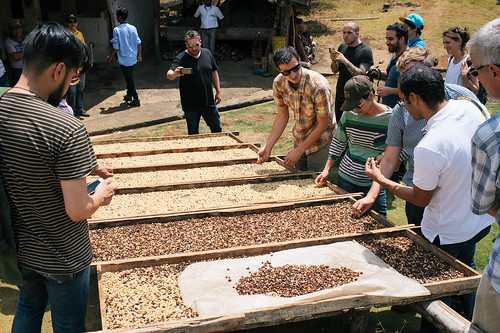El Naranjal, Cauca Best Cup #10
Nylon Coffee Roasters
Luis Alberto picking coffee cherries
This is a little overdue as some might have already seen this coffee on our retail rack & web shop or consumed it at our shop. There is much to share about this coffee which comes from a familiar region called Cauca in Colombia. When we participated in judging for the Cauca Best Cup competition, we were looking out for some special coffees which would be a showcase of what micro-producers can produce with limited resources. We know it is not possible for some small producers to try experimenting with growing different varietals or processing the coffees in very "non-traditional" method because if things do not turn out well, their livelihood will be at risk. They do not have adequate financial resources to be too experimental, hence for these small producers, they can only improve their quality by taking baby steps, such as by improving the picking of only ripe cherries first, then better sorting of the ripes & unripes prior to the fermentation of the cherries.
Typical parabolic dryers found in Colombia, also used in El Naranjal
This new coffee we are rolling out was ranked number 10 in the Cauca Best Cup competition. To refresh a little about this competition, the national cuppers (mainly the cupping team from Banexport) cup through more than 700 coffees that were submitted for this competition. 30 were shortlisted to enter the last few rounds of cupping by international judges during the competition. Together with a group of roasters/buyers from US, Russia and Korea we judged through 3 rounds to narrow down to the top 15 coffees which was auctioned off on the last day of the event. We knew it was a tough fight for some of the top lots as there were some very serious and experienced bidders in the group. The goal of this competition and auction was to motivate and inspire small producers that hard work will be rewarded. We wanted to be part of this movement, so instead of joining the big guys in a bidding war for the top few lots, we bidded for one of the coffees which we really like.
Martha Luz Peña and Luis Alberto Chate overlooking their farm
Ranked at 10th place in the Cauca Best Cup, Finca El Naranjal is owned by Martha Luz Peña. The farm is located in the Caldono municipal of Cauca. Her farm area is approximately 0.8 hectares and all the land is used for coffee production. She has about 2700 trees with a mix of Caturra, Castillo and Colombian. Martha lives in the farm with her husband, Luis Alberto Chate. They have been farming for more than 2 decades. About 5 years ago, they started producing specialty coffee, it was not easy but with lots of effort they are slowly improving each year. With help from Banexport, they started to pick Castillo and Caturra varietals separately. Luis coordinates the cherry pickers during the harvest season. He makes sure that they are doing a good job, so that there would be no unripe beans when it reaches the wet mill. They also monitor the drying process to ensure that the coffee parchment has enough ventilation in the parabolic dryer.
We are proud to share the fruits of Martha & Luis's hard work. It took us a while to start roasting this winning coffee, but we feel most of the Colombians seem to taste better after "acclimatizing" for a few months here in Everton Park. So it is tasting super duper yummy now with more complexity than when we first cupped it. Melange of mandarin orange, plums, hint of florals with cane sugar sweetness. Well-structured body, rounded and smooth.
Farm: El Naranjal
Producer: Martha Luz Peña
Location: Caldono, Cauca
Altitude: ~1850 masl
Varietal: Caturra and Colombia
Processing: Depulped in the afternoon after the cherries are picked. Wet fermentation for 16 hours and fully washed 4 times before drying in traditional parabolic dryers for 4-5 days depending on weather conditions.
This coffee is available now.
PS: Our friends from Patriot Coffee Roasters had this video of the endless cuppings, farm visits of music blasting the local chiva bus and endless discussions/tabulations of scores that culminate to a night of crazy bidding frenzy. Enjoy! :)












